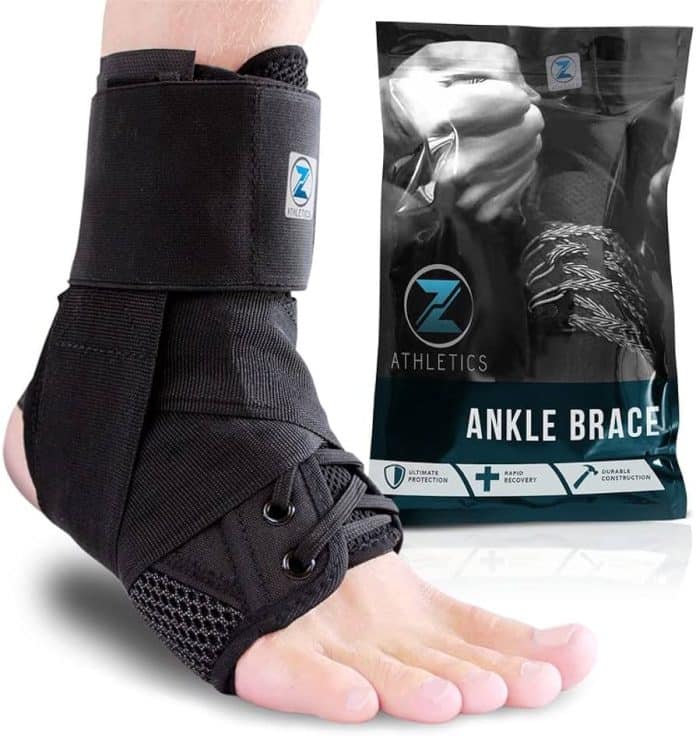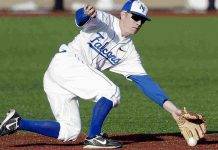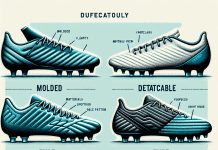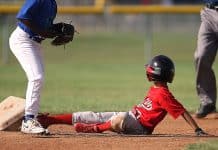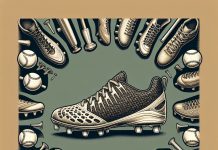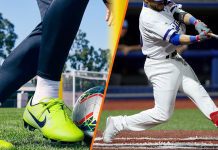In baseball, every player knows that the right equipment is crucial for maximizing performance and preventing injuries. One often overlooked aspect of gear is the importance of ankle support in baseball cleats.
As players sprint across the field, pivot on their toes, and slide into bases, the ankles bear the brunt of the strain and require reliable support.
In this article, we will uncover just how vital ankle support is in baseball cleats, exploring its impact on player performance and injury prevention.
Whether you’re a seasoned pro or just starting, understanding the significance of ankle support will undoubtedly help you up your game on the diamond.
The role of ankle support in baseball cleats
When it comes to playing baseball, the right equipment is essential. And one crucial piece of equipment that often goes overlooked is the baseball cleat. In particular, the role of ankle support in baseball cleats cannot be overstated. Ankle injuries are all too common in sports, and baseball is no exception. Therefore, having proper ankle support in your cleats is essential in preventing injuries, stabilizing the ankle joint, and improving performance and agility on the field.
Review contents
Preventing ankle injuries
Ankle injuries can be painful debilitating, and result in significant time off the field. That’s why preventing these injuries should be a top priority for any baseball player. Ankle support in baseball cleats reduces the risk of sprained ankles, Achilles tendon injuries, and foot and ankle fractures. Cleats with proper ankle support can significantly decrease the chances of suffering from these common injuries by providing stability and protection to the ankle joint.
Stabilizing the ankle joint
The ankle joint is an intricate structure that relies on ligaments, tendons, and muscles to maintain stability. However, baseball’s sudden movements and high-impact nature can put tremendous stress on the ankle joint. The ankle is susceptible to rolling, twisting, and other unnatural movement that can lead to injury without adequate support. Cleats with ankle support provide an additional layer of stability, helping to limit excessive movement and maintain proper alignment of the ankle joint during play.
Improving performance and agility
Beyond injury prevention, ankle support in baseball cleats can also positively impact a player’s performance and agility on the field. When the ankle is supported correctly, it allows for better weight distribution and balance, enabling players to move quickly and precisely.
The added stability can also enhance power transfer from the lower body to the upper body, improving throwing, hitting, and running abilities. With the proper ankle support, players can feel more confident in their movements, enabling them to perform at their best.
Factors to consider in ankle support
Now that we understand the importance of ankle support in baseball cleats let’s explore the factors to consider when choosing the right pair.
Material and construction
The material and construction of the cleat play a crucial role in providing ankle support. High-quality materials such as leather or synthetic uppers offer durability and stability. Reinforced ankle collars and heel counters can enhance support by providing a snug fit and preventing unnecessary movement. It’s essential to choose cleats with sturdy construction that will withstand the demands of the game while providing the necessary ankle support.
Fit and comfort
Proper fit and comfort are vital when it comes to ankle support. Ill-fitting cleats can lead to discomfort, blisters, and even compromised ankle support. Finding the right size and width for your feet is essential, as too loose or tight cleats can cause instability and affect overall performance. Look for cleats with cushioning and padding around the ankle area to ensure comfort without sacrificing support.
Incorporation of ankle support features
Different baseball cleats offer various ankle support features. Some cleats come with high-top designs that provide maximum ankle coverage and support, while others opt for mid-top or low-top designs that balance support and mobility. Consider your specific needs and playing style when choosing the appropriate ankle support feature. Some players may prefer the added support of high-top cleats, while others may prioritize freedom of movement with low-top cleats.
Types of ankle support in baseball cleats
There are three main types of ankle support available in baseball cleats: high-top, mid-top, and low-top cleats.
High-top cleats
High-top cleats provide the most ankle support due to their extended collar that covers the ankle bone. These cleats offer excellent stability and protection against ankle sprains and other injuries. They are particularly beneficial for players with a history of ankle problems or those prioritizing maximum support above all else. However, high-top cleats may somewhat limit ankle mobility, which could impact certain players’ performance.
Mid-top cleats
Mid-top cleats strike a balance between ankle support and mobility. They typically feature a collar that reaches just above the ankle bone, providing adequate support while allowing for greater freedom of movement. These cleats are popular among many baseball players as they offer a good compromise between stability and agility. Mid-top cleats are suitable for players who want ankle support while retaining maneuverability on the field.
Low-top cleats
Low-top cleats are the way to go for players who prioritize agility and mobility above all else. These cleats have a lower collar that rests below the ankle bone, offering the least amount of ankle support compared to high-top and mid-top cleats. While they may not provide the same level of stability, low-top cleats excel in allowing for maximum range of motion, making them a preferred choice for players who rely on quick movements and speed.
Research on ankle support in baseball cleats
Ankle support in baseball cleats has been the subject of numerous research studies. These studies have focused on analyzing injury rates and the effects of ankle support on performance.
Studies analyzing injury rates
Researchers have conducted studies to determine ankle support’s impact on injury rates in baseball cleats. One such study published in the American Journal of Sports Medicine found that athletes wearing cleats with ankle support had a significantly lower risk of ankle sprains than those without ankle support. The study concluded that proper ankle support in cleats reduces ankle injuries in baseball players.
Effects of ankle support on performance
In addition to injury prevention, the effects of ankle support on performance have also been investigated. A study published in the Journal of Strength and Conditioning Research examined the impact of different ankle support levels on agility and performance in baseball players. The study found that players wearing cleats with adequate ankle support demonstrated improved agility, speed, and overall performance compared to those without ankle support. These findings highlight the potential performance benefits of proper ankle support in baseball cleats.
Ankle support and common baseball injuries
Baseball involves a range of movements and activities that can stress the ankle and lead to various injuries. Let’s explore how ankle support in baseball cleats can help prevent some common baseball injuries.
Sprained ankles
Sprained ankles are one of the most prevalent injuries in baseball. The sudden twists, turns, and lateral movements involved in the sport can stretch or tear ankle ligaments. Ankle support in cleats can provide stability and limit excessive movement, reducing the risk of sprained ankles. Cleats with ankle support can help prevent the strain and overextension that commonly lead to sprains by adequately aligning the ankle joint.
Achilles tendon injuries
The Achilles tendon, located at the back of the ankle, is critical for running and jumping activities in baseball. However, it is also susceptible to injury, particularly in sports involving explosive movements. Cleats with ankle support can help protect the Achilles tendon by reducing excessive strain and maintaining proper ankle joint alignment. This added support can minimize the risk of Achilles tendonitis, tears, and other related injuries.
Foot and ankle fractures
The fast-paced nature of baseball, combined with occasional collisions and impact with hard surfaces, puts players at risk of foot and ankle fractures. Ankle support in cleats can provide an extra layer of protection by stabilizing the ankle joint and absorbing some of the shock from high-impact movements. While cleats cannot entirely prevent fractures, they can help reduce the severity and frequency of these injuries.
The influence of player positions on ankle support needs
Different player positions in baseball require varying levels of ankle support. Let’s explore how ankle support needs differ depending on the position played.
Pitchers
Pitchers are often subject to intense lower body movements and shifting weight during delivery. Cleats with proper ankle support are crucial for pitchers to maintain stability and balance while generating power from their lower body. Ankle support can help prevent injuries from the stress placed on the ankle joint during the pitching motion.
Catchers
Catchers face unique challenges and stresses on their ankles due to constant crouching, squatting, and sudden movements. Ankle support in cleats becomes even more critical for catchers to provide stability and protect against ankle injuries. The added support can help catchers maintain balance and prevent ankle sprains when blocking balls in the dirt or making quick movements behind the plate.
Infielders
Infielders require quick reflexes, agility, and lateral movements when fielding ground balls and making throws. Cleats with proper ankle support can help infielders maintain stability during these dynamic motions, reducing the risk of ankle sprains and enhancing overall performance. The ability to move laterally confidently allows infielders to react quicker and make accurate throws to secure outs.
Outfielders
Outfielders cover large field areas and often need to sprint, jump, and change directions rapidly. These movements significantly demand the ankles, making proper ankle support crucial for outfielders. Cleats with adequate ankle support can provide stability during high-intensity actions, such as jumping to make catches at the wall or sprinting to cut off a ball in the gap.
Personal preferences in ankle support
While there are general considerations for ankle support in baseball cleats, personal preferences also play a role in choosing the right level of ankle support. Here are some factors to consider when selecting cleats based on personal preferences.
Previous injury history
Players with a history of ankle injuries may require additional ankle support to minimize re-injury risk. In such cases, high-top cleats with an extended collar can provide the stability and confidence to protect against future injuries.
Comfort
Comfort is a significant factor in determining the level of ankle support a player prefers. Some players may find high-top cleats too restrictive or uncomfortable, while others may value the added support and feel more secure on the field. Finding a balance between comfort and ankle support is essential to ensure players perform at their best.
Player style and preference
Different players have different playing styles and preferences regarding ankle support. Some may prioritize speed, agility, and range of motion, leaning towards low-top cleats. Others may prioritize stability and protection, opting for high-top cleats. Ultimately, finding the right ankle support level depends on each player’s unique style and preference.
Choosing the right ankle support level
Now that we have explored the factors influencing ankle support in baseball cleats let’s discuss choosing the appropriate ankle support level.
Severity of ankle instability
The severity of ankle instability should be a key consideration when choosing the right ankle support level. Players with a history of chronic ankle instability or those prone to frequent ankle sprains may benefit from high-top cleats that provide maximum stability. Conversely, players with no history of ankle instability may opt for mid-top or low-top cleats to balance support and freedom of movement.
Playing conditions and field surface
The playing conditions and field surface can also inform the choice of ankle support level. For instance, playing on uneven or slippery surfaces may warrant a higher level of ankle support to mitigate the risk of injuries. Similarly, playing in wet conditions may require cleats with superior traction and ankle support to maintain stability and prevent slips.
Individual preferences
Individual preferences should play a significant role in choosing the right ankle support level. Try on different styles and sizes of cleats to assess comfort and determine the level of support that feels right for you. Remember that what works for one player may not work for another, so it’s essential to prioritize your preferences and comfort when deciding.
Additional measures for ankle support
While proper ankle support in cleats is crucial, there are also additional measures that players can take to enhance ankle stability and prevent injuries.
Ankle braces and wraps
Ankle braces and wraps are external support devices worn with baseball cleats to provide added ankle support. These devices help restrict excessive movement and offer additional stability to the ankle joint. They are handy for players with a history of ankle injuries or requiring extra confidence and protection on the field.
Ankle taping techniques
Ankle taping is common among athletes to enhance ankle support and stability. Using athletic tape, the ankle can be secured to limit excessive movement and provide added support during play. Learning proper ankle-taping techniques from a trained professional can benefit players wishing to supplement their ankle support in cleats.
Strength and flexibility exercises
Building strength and flexibility in the muscles surrounding the ankle can significantly contribute to ankle stability. Incorporating exercises that target the calf muscles, ankle stabilizers, and proprioception can help improve balance, reduce the risk of injury, and enhance overall ankle support. Consulting with a qualified strength and conditioning coach can guide specific exercises tailored to a player’s needs and goals.
The future of ankle support in baseball cleats
As technology advances, so does the potential for improved ankle support in baseball cleats. Here are some potential developments to look forward to in the future.
Technological advancements
Manufacturers are constantly exploring new materials and technologies to enhance the ankle support capabilities of baseball cleats. From improved cushioning systems to innovative lace-up designs, technological advancements aim to provide players with optimal ankle support while maximizing comfort and performance.
Customization options
The ability to customize baseball cleats to fit an individual’s specific needs and preferences is an area of potential growth. Customization options may include adjustable ankle support features, personalized fit adjustments, and the ability to select different ankle collar heights. These advancements could allow each player to tailor their cleats to provide the ideal level of ankle support.
Collaborations between footwear manufacturers and medical professionals
Collaborations between footwear manufacturers and medical professionals, such as sports medicine specialists and podiatrists, could lead to significant advancements in ankle support technology. By combining expertise in athletic performance and injury prevention, these collaborations could result in cleat designs that offer unparalleled ankle support and protection.
In conclusion, ankle support plays a crucial role in baseball cleats. It helps prevent ankle injuries, stabilizes the ankle joint, and improves overall performance and agility on the field. Material, construction, fit, comfort, and ankle support should be considered when selecting cleats.
Different types of ankle support exist, including high-top, mid-top, and low-top cleats, each offering varying levels of ankle coverage and support. Extensive research supports the link between ankle support, injury prevention, and performance enhancement. Ankle support is particularly relevant for common baseball injuries such as sprained ankles, Achilles tendon injuries, and foot and ankle fractures.
Additionally, players’ specific ankle support needs can vary based on their positions and individual preferences. Considerations such as previous injury history, comfort, and player style should influence the choice of ankle support level. While ankle support in cleats is essential, players can enhance ankle stability through ankle braces and wraps, ankle taping techniques, and strength and flexibility exercises.
The future of ankle support in baseball cleats looks promising, with potential technological advancements, customization options, and collaborations between footwear manufacturers and medical professionals.
By prioritizing ankle support and taking proactive measures, baseball players can reduce the risk of ankle injuries and optimize their performance on the field.


